STT100 Statistics for Business: Investigating Gender Differences
VerifiedAdded on 2023/03/31
|8
|1641
|108
Report
AI Summary
This study investigates whether significant differences exist in the average mathematics test scores between male and female students. Using a sample of 100 college students and their recent mathematics test scores, the research employs descriptive and inferential statistics, including an independent samples t-test, to test the hypothesis that there is no significant difference in mean scores between the two groups. The results indicate that male students, on average, perform better than female students, supporting the alternative hypothesis. The report includes summary statistics, histograms, and box plots to visualize the data distribution and identify any outliers. The conclusion emphasizes the findings and references previous studies with contradictory results, contributing to the ongoing discussion on gender differences in mathematics performance. Desklib provides access to this and similar solved assignments for students.

Statistics for Business
Student Name:
Student Number:
29th May 2019
Student Name:
Student Number:
29th May 2019
Paraphrase This Document
Need a fresh take? Get an instant paraphrase of this document with our AI Paraphraser
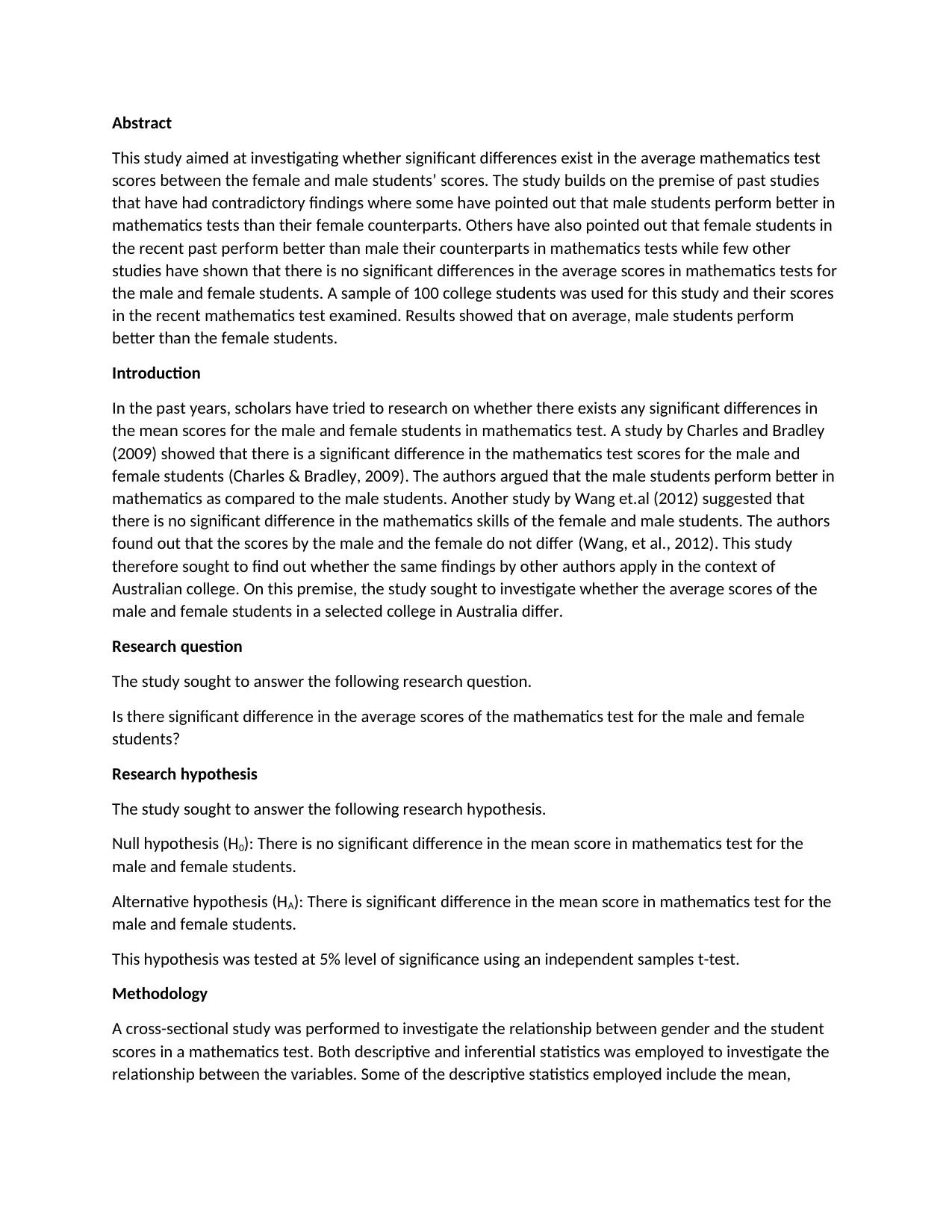
Abstract
This study aimed at investigating whether significant differences exist in the average mathematics test
scores between the female and male students’ scores. The study builds on the premise of past studies
that have had contradictory findings where some have pointed out that male students perform better in
mathematics tests than their female counterparts. Others have also pointed out that female students in
the recent past perform better than male their counterparts in mathematics tests while few other
studies have shown that there is no significant differences in the average scores in mathematics tests for
the male and female students. A sample of 100 college students was used for this study and their scores
in the recent mathematics test examined. Results showed that on average, male students perform
better than the female students.
Introduction
In the past years, scholars have tried to research on whether there exists any significant differences in
the mean scores for the male and female students in mathematics test. A study by Charles and Bradley
(2009) showed that there is a significant difference in the mathematics test scores for the male and
female students (Charles & Bradley, 2009). The authors argued that the male students perform better in
mathematics as compared to the male students. Another study by Wang et.al (2012) suggested that
there is no significant difference in the mathematics skills of the female and male students. The authors
found out that the scores by the male and the female do not differ (Wang, et al., 2012). This study
therefore sought to find out whether the same findings by other authors apply in the context of
Australian college. On this premise, the study sought to investigate whether the average scores of the
male and female students in a selected college in Australia differ.
Research question
The study sought to answer the following research question.
Is there significant difference in the average scores of the mathematics test for the male and female
students?
Research hypothesis
The study sought to answer the following research hypothesis.
Null hypothesis (H0): There is no significant difference in the mean score in mathematics test for the
male and female students.
Alternative hypothesis (HA): There is significant difference in the mean score in mathematics test for the
male and female students.
This hypothesis was tested at 5% level of significance using an independent samples t-test.
Methodology
A cross-sectional study was performed to investigate the relationship between gender and the student
scores in a mathematics test. Both descriptive and inferential statistics was employed to investigate the
relationship between the variables. Some of the descriptive statistics employed include the mean,
This study aimed at investigating whether significant differences exist in the average mathematics test
scores between the female and male students’ scores. The study builds on the premise of past studies
that have had contradictory findings where some have pointed out that male students perform better in
mathematics tests than their female counterparts. Others have also pointed out that female students in
the recent past perform better than male their counterparts in mathematics tests while few other
studies have shown that there is no significant differences in the average scores in mathematics tests for
the male and female students. A sample of 100 college students was used for this study and their scores
in the recent mathematics test examined. Results showed that on average, male students perform
better than the female students.
Introduction
In the past years, scholars have tried to research on whether there exists any significant differences in
the mean scores for the male and female students in mathematics test. A study by Charles and Bradley
(2009) showed that there is a significant difference in the mathematics test scores for the male and
female students (Charles & Bradley, 2009). The authors argued that the male students perform better in
mathematics as compared to the male students. Another study by Wang et.al (2012) suggested that
there is no significant difference in the mathematics skills of the female and male students. The authors
found out that the scores by the male and the female do not differ (Wang, et al., 2012). This study
therefore sought to find out whether the same findings by other authors apply in the context of
Australian college. On this premise, the study sought to investigate whether the average scores of the
male and female students in a selected college in Australia differ.
Research question
The study sought to answer the following research question.
Is there significant difference in the average scores of the mathematics test for the male and female
students?
Research hypothesis
The study sought to answer the following research hypothesis.
Null hypothesis (H0): There is no significant difference in the mean score in mathematics test for the
male and female students.
Alternative hypothesis (HA): There is significant difference in the mean score in mathematics test for the
male and female students.
This hypothesis was tested at 5% level of significance using an independent samples t-test.
Methodology
A cross-sectional study was performed to investigate the relationship between gender and the student
scores in a mathematics test. Both descriptive and inferential statistics was employed to investigate the
relationship between the variables. Some of the descriptive statistics employed include the mean,
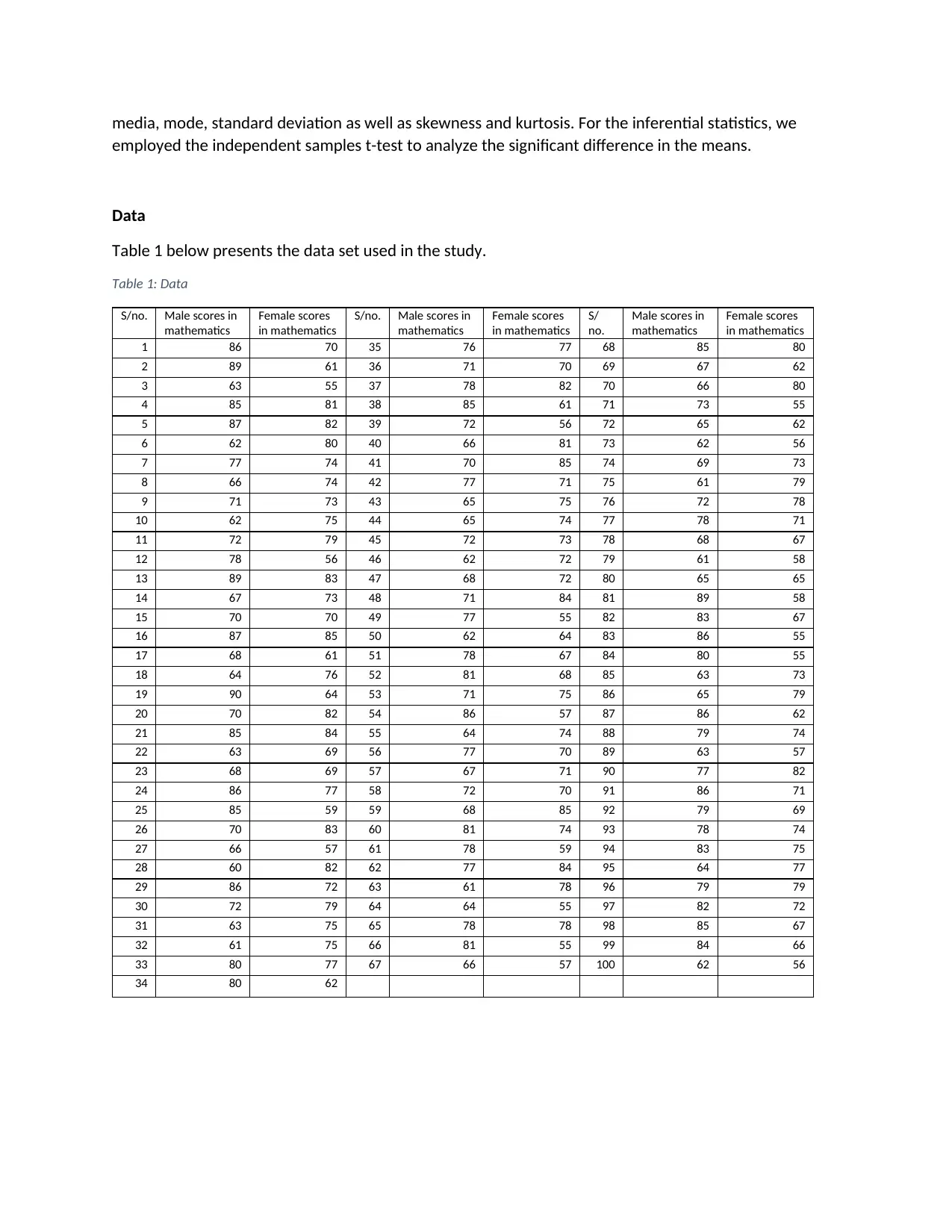
media, mode, standard deviation as well as skewness and kurtosis. For the inferential statistics, we
employed the independent samples t-test to analyze the significant difference in the means.
Data
Table 1 below presents the data set used in the study.
Table 1: Data
S/no. Male scores in
mathematics
Female scores
in mathematics
S/no. Male scores in
mathematics
Female scores
in mathematics
S/
no.
Male scores in
mathematics
Female scores
in mathematics
1 86 70 35 76 77 68 85 80
2 89 61 36 71 70 69 67 62
3 63 55 37 78 82 70 66 80
4 85 81 38 85 61 71 73 55
5 87 82 39 72 56 72 65 62
6 62 80 40 66 81 73 62 56
7 77 74 41 70 85 74 69 73
8 66 74 42 77 71 75 61 79
9 71 73 43 65 75 76 72 78
10 62 75 44 65 74 77 78 71
11 72 79 45 72 73 78 68 67
12 78 56 46 62 72 79 61 58
13 89 83 47 68 72 80 65 65
14 67 73 48 71 84 81 89 58
15 70 70 49 77 55 82 83 67
16 87 85 50 62 64 83 86 55
17 68 61 51 78 67 84 80 55
18 64 76 52 81 68 85 63 73
19 90 64 53 71 75 86 65 79
20 70 82 54 86 57 87 86 62
21 85 84 55 64 74 88 79 74
22 63 69 56 77 70 89 63 57
23 68 69 57 67 71 90 77 82
24 86 77 58 72 70 91 86 71
25 85 59 59 68 85 92 79 69
26 70 83 60 81 74 93 78 74
27 66 57 61 78 59 94 83 75
28 60 82 62 77 84 95 64 77
29 86 72 63 61 78 96 79 79
30 72 79 64 64 55 97 82 72
31 63 75 65 78 78 98 85 67
32 61 75 66 81 55 99 84 66
33 80 77 67 66 57 100 62 56
34 80 62
employed the independent samples t-test to analyze the significant difference in the means.
Data
Table 1 below presents the data set used in the study.
Table 1: Data
S/no. Male scores in
mathematics
Female scores
in mathematics
S/no. Male scores in
mathematics
Female scores
in mathematics
S/
no.
Male scores in
mathematics
Female scores
in mathematics
1 86 70 35 76 77 68 85 80
2 89 61 36 71 70 69 67 62
3 63 55 37 78 82 70 66 80
4 85 81 38 85 61 71 73 55
5 87 82 39 72 56 72 65 62
6 62 80 40 66 81 73 62 56
7 77 74 41 70 85 74 69 73
8 66 74 42 77 71 75 61 79
9 71 73 43 65 75 76 72 78
10 62 75 44 65 74 77 78 71
11 72 79 45 72 73 78 68 67
12 78 56 46 62 72 79 61 58
13 89 83 47 68 72 80 65 65
14 67 73 48 71 84 81 89 58
15 70 70 49 77 55 82 83 67
16 87 85 50 62 64 83 86 55
17 68 61 51 78 67 84 80 55
18 64 76 52 81 68 85 63 73
19 90 64 53 71 75 86 65 79
20 70 82 54 86 57 87 86 62
21 85 84 55 64 74 88 79 74
22 63 69 56 77 70 89 63 57
23 68 69 57 67 71 90 77 82
24 86 77 58 72 70 91 86 71
25 85 59 59 68 85 92 79 69
26 70 83 60 81 74 93 78 74
27 66 57 61 78 59 94 83 75
28 60 82 62 77 84 95 64 77
29 86 72 63 61 78 96 79 79
30 72 79 64 64 55 97 82 72
31 63 75 65 78 78 98 85 67
32 61 75 66 81 55 99 84 66
33 80 77 67 66 57 100 62 56
34 80 62
⊘ This is a preview!⊘
Do you want full access?
Subscribe today to unlock all pages.

Trusted by 1+ million students worldwide
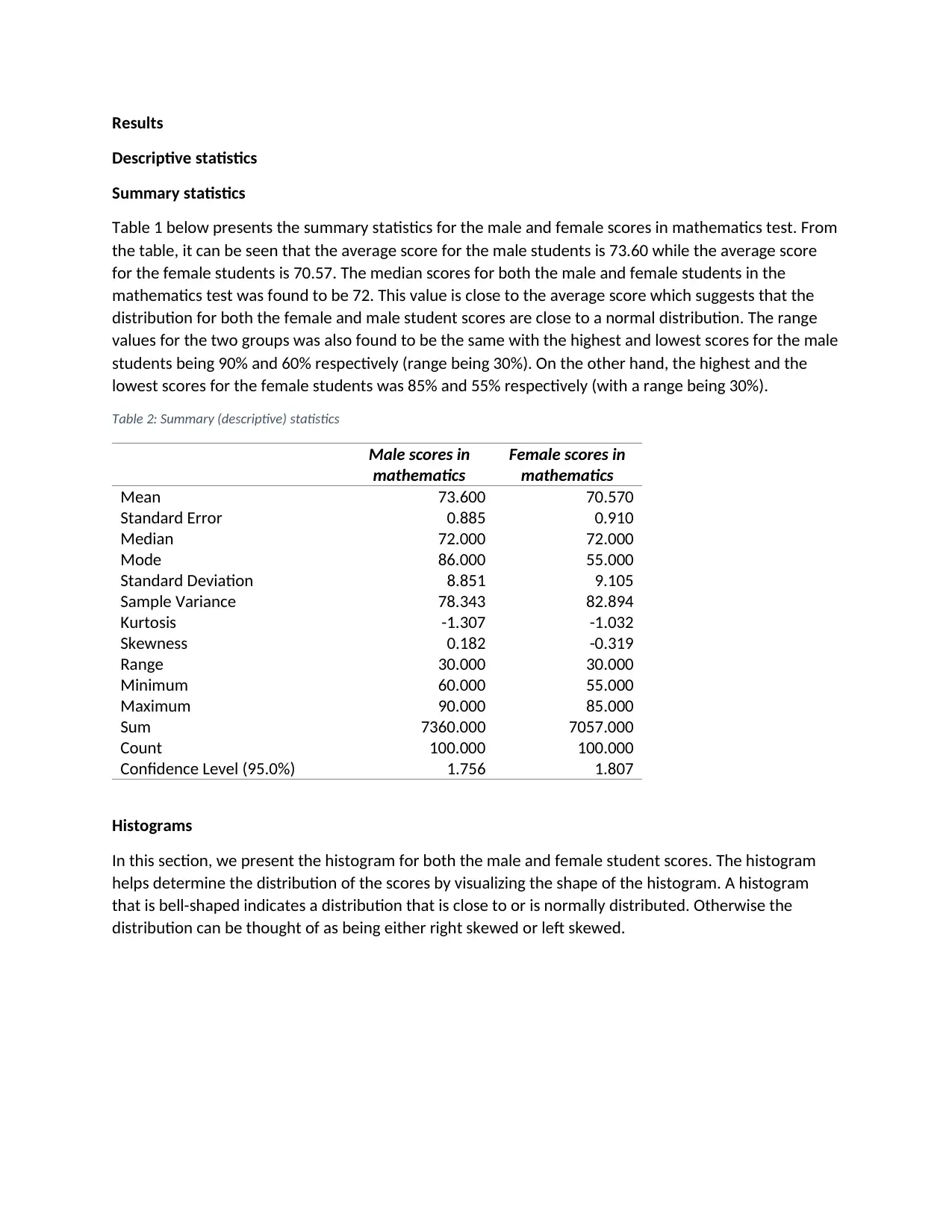
Results
Descriptive statistics
Summary statistics
Table 1 below presents the summary statistics for the male and female scores in mathematics test. From
the table, it can be seen that the average score for the male students is 73.60 while the average score
for the female students is 70.57. The median scores for both the male and female students in the
mathematics test was found to be 72. This value is close to the average score which suggests that the
distribution for both the female and male student scores are close to a normal distribution. The range
values for the two groups was also found to be the same with the highest and lowest scores for the male
students being 90% and 60% respectively (range being 30%). On the other hand, the highest and the
lowest scores for the female students was 85% and 55% respectively (with a range being 30%).
Table 2: Summary (descriptive) statistics
Male scores in
mathematics
Female scores in
mathematics
Mean 73.600 70.570
Standard Error 0.885 0.910
Median 72.000 72.000
Mode 86.000 55.000
Standard Deviation 8.851 9.105
Sample Variance 78.343 82.894
Kurtosis -1.307 -1.032
Skewness 0.182 -0.319
Range 30.000 30.000
Minimum 60.000 55.000
Maximum 90.000 85.000
Sum 7360.000 7057.000
Count 100.000 100.000
Confidence Level (95.0%) 1.756 1.807
Histograms
In this section, we present the histogram for both the male and female student scores. The histogram
helps determine the distribution of the scores by visualizing the shape of the histogram. A histogram
that is bell-shaped indicates a distribution that is close to or is normally distributed. Otherwise the
distribution can be thought of as being either right skewed or left skewed.
Descriptive statistics
Summary statistics
Table 1 below presents the summary statistics for the male and female scores in mathematics test. From
the table, it can be seen that the average score for the male students is 73.60 while the average score
for the female students is 70.57. The median scores for both the male and female students in the
mathematics test was found to be 72. This value is close to the average score which suggests that the
distribution for both the female and male student scores are close to a normal distribution. The range
values for the two groups was also found to be the same with the highest and lowest scores for the male
students being 90% and 60% respectively (range being 30%). On the other hand, the highest and the
lowest scores for the female students was 85% and 55% respectively (with a range being 30%).
Table 2: Summary (descriptive) statistics
Male scores in
mathematics
Female scores in
mathematics
Mean 73.600 70.570
Standard Error 0.885 0.910
Median 72.000 72.000
Mode 86.000 55.000
Standard Deviation 8.851 9.105
Sample Variance 78.343 82.894
Kurtosis -1.307 -1.032
Skewness 0.182 -0.319
Range 30.000 30.000
Minimum 60.000 55.000
Maximum 90.000 85.000
Sum 7360.000 7057.000
Count 100.000 100.000
Confidence Level (95.0%) 1.756 1.807
Histograms
In this section, we present the histogram for both the male and female student scores. The histogram
helps determine the distribution of the scores by visualizing the shape of the histogram. A histogram
that is bell-shaped indicates a distribution that is close to or is normally distributed. Otherwise the
distribution can be thought of as being either right skewed or left skewed.
Paraphrase This Document
Need a fresh take? Get an instant paraphrase of this document with our AI Paraphraser
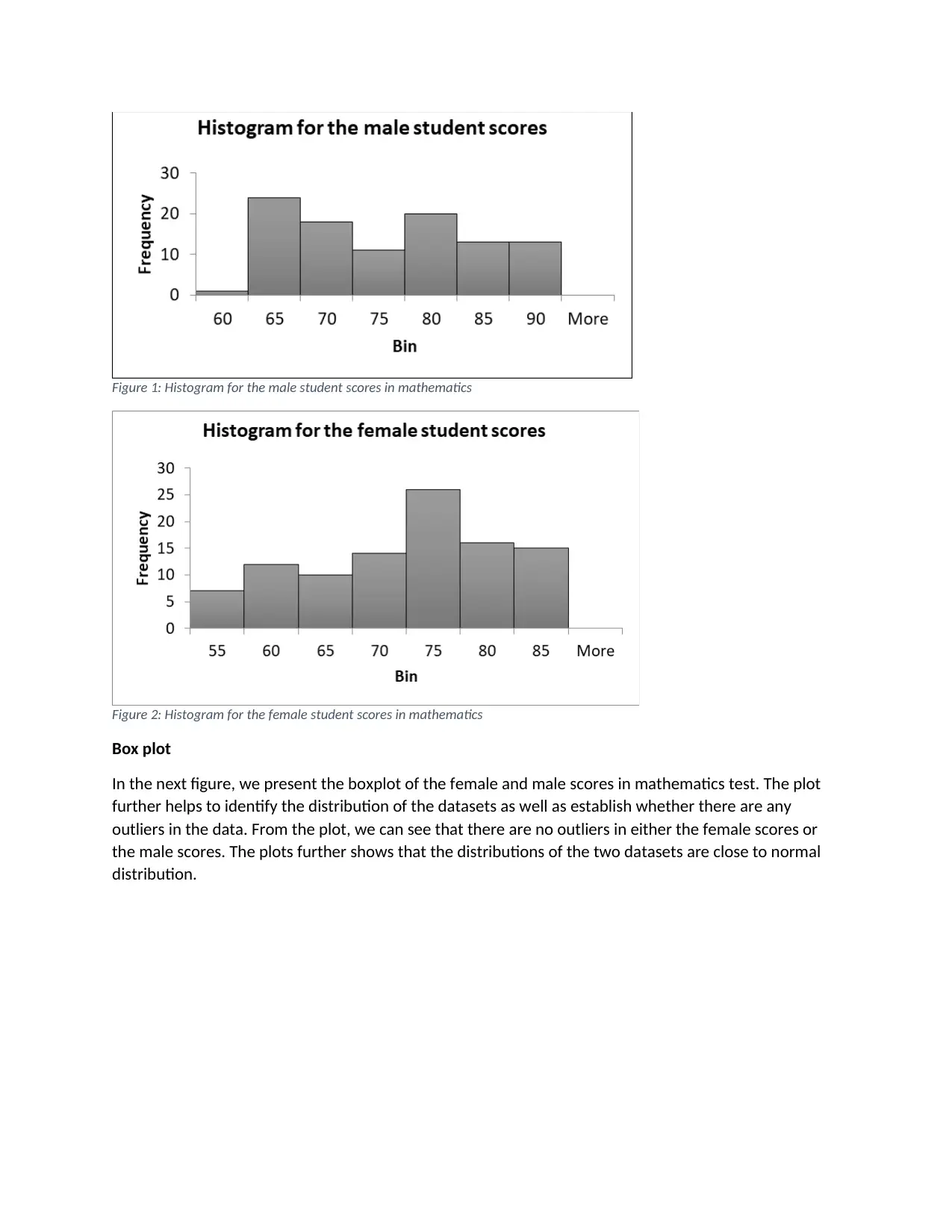
Figure 1: Histogram for the male student scores in mathematics
Figure 2: Histogram for the female student scores in mathematics
Box plot
In the next figure, we present the boxplot of the female and male scores in mathematics test. The plot
further helps to identify the distribution of the datasets as well as establish whether there are any
outliers in the data. From the plot, we can see that there are no outliers in either the female scores or
the male scores. The plots further shows that the distributions of the two datasets are close to normal
distribution.
Figure 2: Histogram for the female student scores in mathematics
Box plot
In the next figure, we present the boxplot of the female and male scores in mathematics test. The plot
further helps to identify the distribution of the datasets as well as establish whether there are any
outliers in the data. From the plot, we can see that there are no outliers in either the female scores or
the male scores. The plots further shows that the distributions of the two datasets are close to normal
distribution.
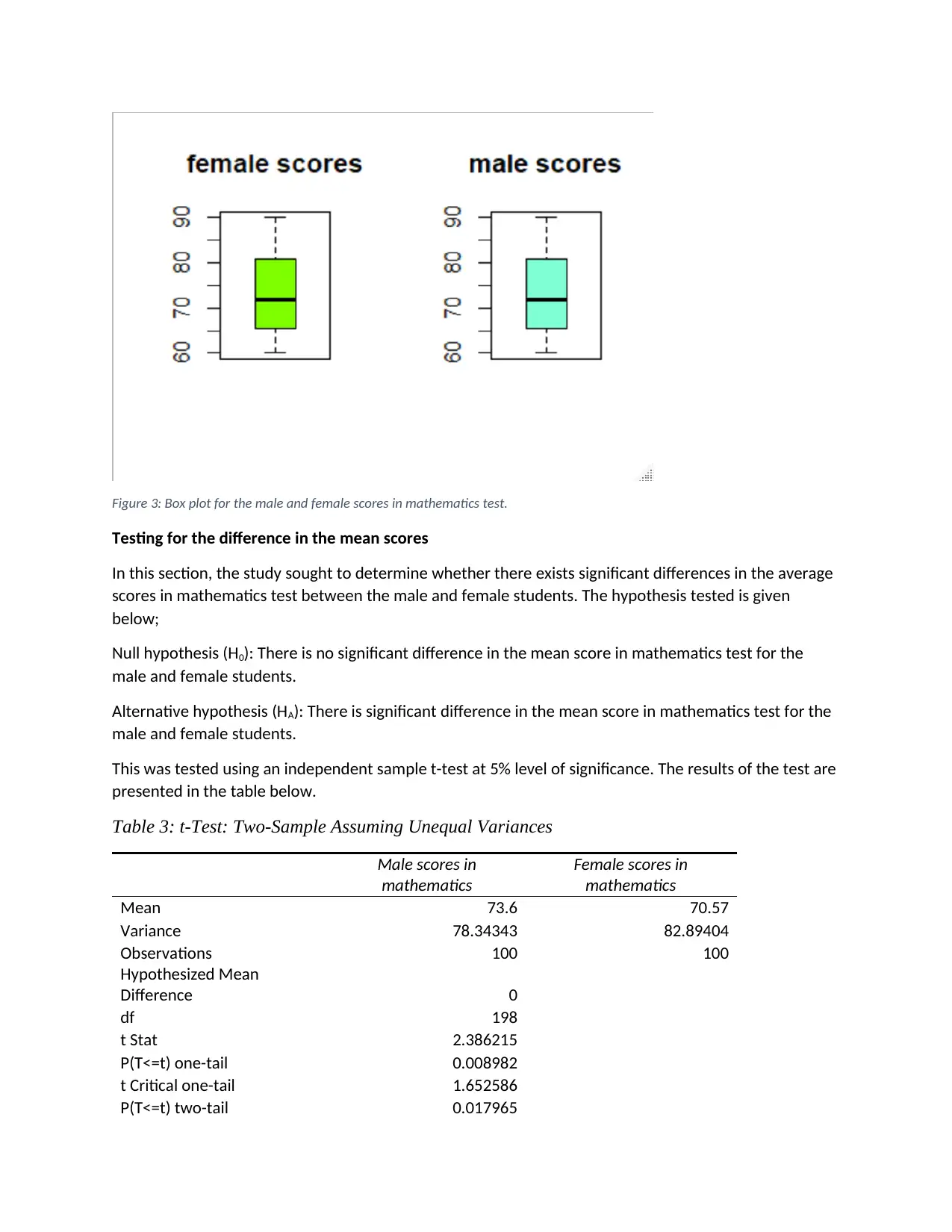
Figure 3: Box plot for the male and female scores in mathematics test.
Testing for the difference in the mean scores
In this section, the study sought to determine whether there exists significant differences in the average
scores in mathematics test between the male and female students. The hypothesis tested is given
below;
Null hypothesis (H0): There is no significant difference in the mean score in mathematics test for the
male and female students.
Alternative hypothesis (HA): There is significant difference in the mean score in mathematics test for the
male and female students.
This was tested using an independent sample t-test at 5% level of significance. The results of the test are
presented in the table below.
Table 3: t-Test: Two-Sample Assuming Unequal Variances
Male scores in
mathematics
Female scores in
mathematics
Mean 73.6 70.57
Variance 78.34343 82.89404
Observations 100 100
Hypothesized Mean
Difference 0
df 198
t Stat 2.386215
P(T<=t) one-tail 0.008982
t Critical one-tail 1.652586
P(T<=t) two-tail 0.017965
Testing for the difference in the mean scores
In this section, the study sought to determine whether there exists significant differences in the average
scores in mathematics test between the male and female students. The hypothesis tested is given
below;
Null hypothesis (H0): There is no significant difference in the mean score in mathematics test for the
male and female students.
Alternative hypothesis (HA): There is significant difference in the mean score in mathematics test for the
male and female students.
This was tested using an independent sample t-test at 5% level of significance. The results of the test are
presented in the table below.
Table 3: t-Test: Two-Sample Assuming Unequal Variances
Male scores in
mathematics
Female scores in
mathematics
Mean 73.6 70.57
Variance 78.34343 82.89404
Observations 100 100
Hypothesized Mean
Difference 0
df 198
t Stat 2.386215
P(T<=t) one-tail 0.008982
t Critical one-tail 1.652586
P(T<=t) two-tail 0.017965
⊘ This is a preview!⊘
Do you want full access?
Subscribe today to unlock all pages.

Trusted by 1+ million students worldwide
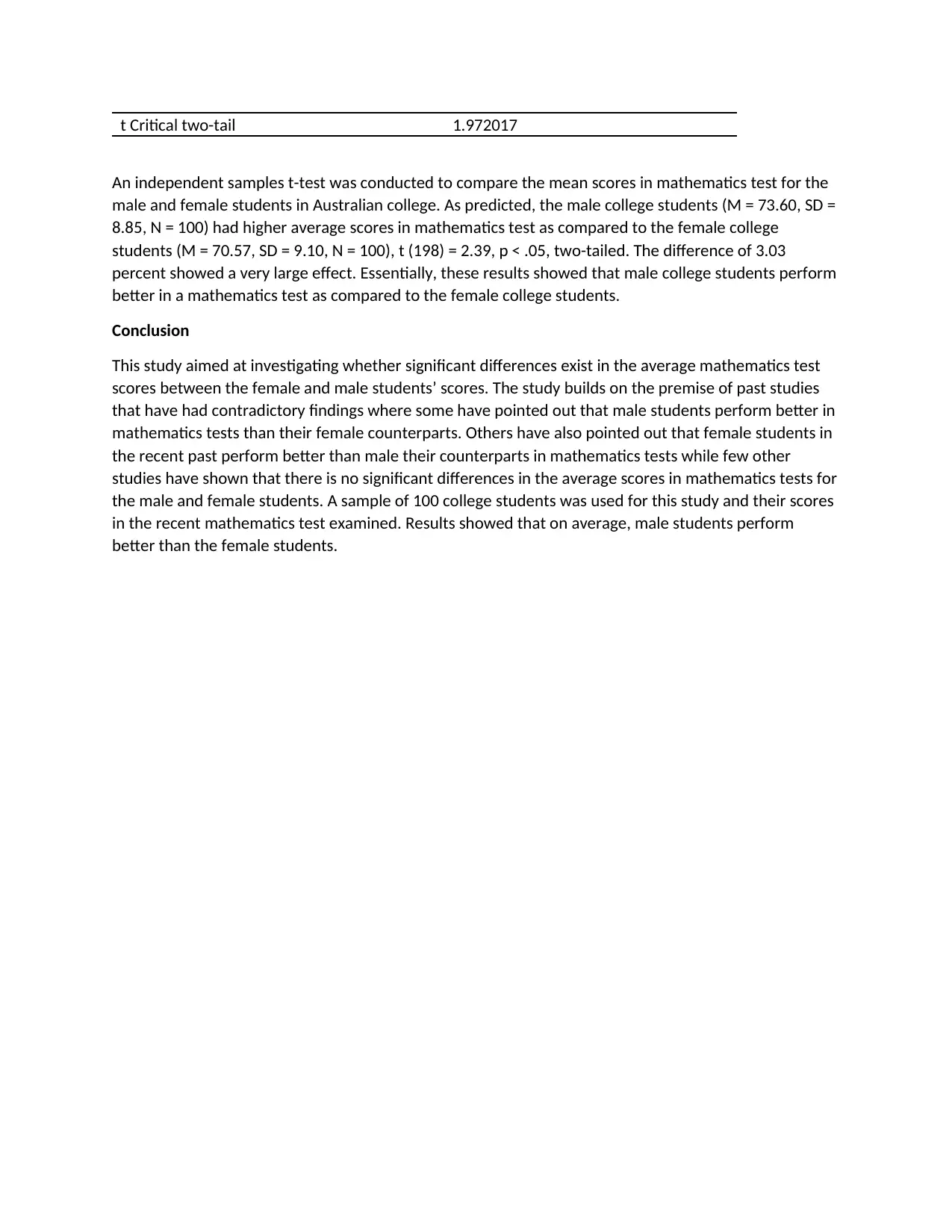
t Critical two-tail 1.972017
An independent samples t-test was conducted to compare the mean scores in mathematics test for the
male and female students in Australian college. As predicted, the male college students (M = 73.60, SD =
8.85, N = 100) had higher average scores in mathematics test as compared to the female college
students (M = 70.57, SD = 9.10, N = 100), t (198) = 2.39, p < .05, two-tailed. The difference of 3.03
percent showed a very large effect. Essentially, these results showed that male college students perform
better in a mathematics test as compared to the female college students.
Conclusion
This study aimed at investigating whether significant differences exist in the average mathematics test
scores between the female and male students’ scores. The study builds on the premise of past studies
that have had contradictory findings where some have pointed out that male students perform better in
mathematics tests than their female counterparts. Others have also pointed out that female students in
the recent past perform better than male their counterparts in mathematics tests while few other
studies have shown that there is no significant differences in the average scores in mathematics tests for
the male and female students. A sample of 100 college students was used for this study and their scores
in the recent mathematics test examined. Results showed that on average, male students perform
better than the female students.
An independent samples t-test was conducted to compare the mean scores in mathematics test for the
male and female students in Australian college. As predicted, the male college students (M = 73.60, SD =
8.85, N = 100) had higher average scores in mathematics test as compared to the female college
students (M = 70.57, SD = 9.10, N = 100), t (198) = 2.39, p < .05, two-tailed. The difference of 3.03
percent showed a very large effect. Essentially, these results showed that male college students perform
better in a mathematics test as compared to the female college students.
Conclusion
This study aimed at investigating whether significant differences exist in the average mathematics test
scores between the female and male students’ scores. The study builds on the premise of past studies
that have had contradictory findings where some have pointed out that male students perform better in
mathematics tests than their female counterparts. Others have also pointed out that female students in
the recent past perform better than male their counterparts in mathematics tests while few other
studies have shown that there is no significant differences in the average scores in mathematics tests for
the male and female students. A sample of 100 college students was used for this study and their scores
in the recent mathematics test examined. Results showed that on average, male students perform
better than the female students.
Paraphrase This Document
Need a fresh take? Get an instant paraphrase of this document with our AI Paraphraser

References
Charles, M. & Bradley, K., 2009. Indulging our gendered selves? Sex segregation by field of study in 44
countries. American Journal of Sociology, 114(4), p. 924–976.
Wang, Z., Osterlind, S. & Bergin, D., 2012. Building mathematics achievement models in four countries
using TIMSS 2003. International Journal of Science and Mathematics Education, 10(5), p. 1215–1242..
Charles, M. & Bradley, K., 2009. Indulging our gendered selves? Sex segregation by field of study in 44
countries. American Journal of Sociology, 114(4), p. 924–976.
Wang, Z., Osterlind, S. & Bergin, D., 2012. Building mathematics achievement models in four countries
using TIMSS 2003. International Journal of Science and Mathematics Education, 10(5), p. 1215–1242..
1 out of 8
Related Documents
Your All-in-One AI-Powered Toolkit for Academic Success.
+13062052269
info@desklib.com
Available 24*7 on WhatsApp / Email
![[object Object]](/_next/static/media/star-bottom.7253800d.svg)
Unlock your academic potential
Copyright © 2020–2025 A2Z Services. All Rights Reserved. Developed and managed by ZUCOL.





